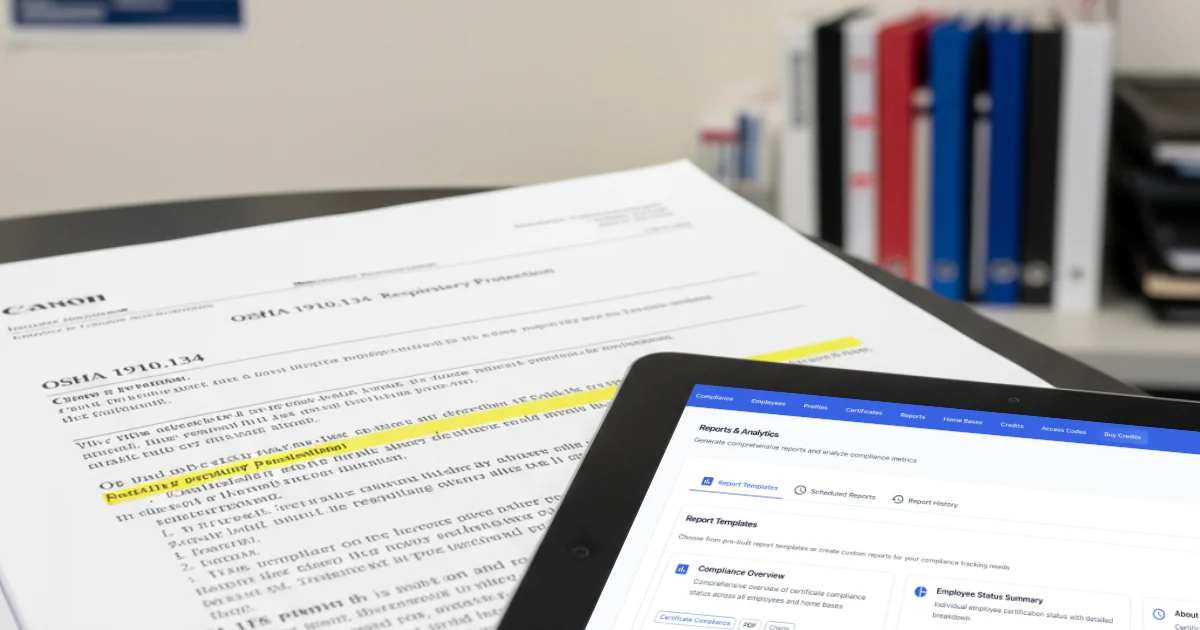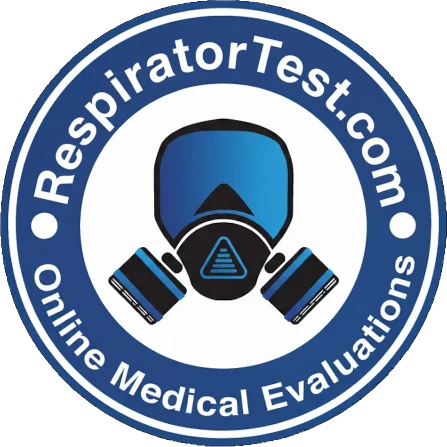OSHA 1910.134 Respirator Medical Evaluation Requirements: Complete Compliance Guide
RespiratorTest Team
15 min read
Updated: October 10, 2025

If your employees use respirators in the workplace—whether for dust protection, chemical exposure, or hazardous atmospheres—OSHA's 1910.134 Respiratory Protection Standard requires medical evaluations before they can be assigned a respirator. This requirement applies to every industry from construction and manufacturing to healthcare and municipal services.
But what exactly does OSHA require? Who needs these evaluations? How often must they be conducted? And what happens if you're not compliant?
This comprehensive guide answers all your questions about OSHA 1910.134 respirator medical evaluation requirements, helping you achieve and maintain compliance while protecting your workforce.
What is OSHA 1910.134?
OSHA 1910.134 is the federal Respiratory Protection Standard that establishes minimum requirements for respiratory protection programs in workplaces where respirators are necessary to protect employee health. The standard applies to general industry, construction, shipyard employment, longshoring, and marine terminals.
The regulation covers everything from respirator selection and medical evaluations to fit testing, training, maintenance, and recordkeeping. Medical evaluation is specifically addressed in section 1910.134(e), which requires employers to provide medical evaluations to determine each employee's ability to safely use a respirator.
Why does OSHA mandate medical evaluations?
Wearing a respirator increases breathing resistance and physiological stress. Employees with certain medical conditions—such as heart disease, lung conditions, or claustrophobia—may experience serious health consequences when using respiratory protection. A medical evaluation identifies these risks before they become workplace emergencies.
Who Needs a Respirator Medical Evaluation?
According to OSHA 1910.134(e)(1), employers must provide a medical evaluation to determine an employee's ability to use a respirator before the employee is fit tested or required to use the respirator in the workplace.
You must provide medical evaluations for:
- • Any employee required to wear a tight-fitting respirator (half-mask or full-facepiece)
- • Employees using powered air-purifying respirators (PAPRs)
- • Workers assigned self-contained breathing apparatus (SCBA)
- • Employees required to use any respirator as part of their job duties
Medical evaluations are NOT required for:
Voluntary use of filtering facepiece respirators (like disposable N95 masks) when the employer does not require respirator use and the work environment does not require respiratory protection per OSHA standards. However, employers must still provide Appendix D information to employees using respirators voluntarily.
Need help streamlining your OSHA respirator medical evaluations?
RespiratorTest.com provides fast, affordable, PLHCP-reviewed online evaluations that reduce costs by 70% while maintaining full OSHA 1910.134 compliance. Complete evaluations in 10 minutes with instant results, automated tracking, and digital certificates.
Get Started with 2 Free CreditsWhat Does the Medical Evaluation Include?
OSHA requires that the medical evaluation include completion of a medical questionnaire (Appendix C to 1910.134) or an initial medical examination that obtains the same information.
The OSHA Appendix C Questionnaire
The mandatory medical questionnaire in Appendix C consists of three parts:
Part A, Section 1: General Information
- • Employee demographics (age, sex, height, weight)
- • Job title and work location
- • Type of respirator to be used
- • Weight and duration of use
- • Work effort level
- • Workplace temperatures and conditions
Part A, Section 2: Medical History (9 mandatory questions)
These questions screen for conditions that may affect respirator use:
- • Cardiovascular conditions (chest pain, heart problems)
- • Respiratory conditions (asthma, emphysema, breathing difficulties)
- • Other relevant medical history
How Often Are Medical Evaluations Required?
OSHA requires medical evaluations at specific intervals:
Initial Evaluation
Before an employee is assigned a respirator, fit tested, or required to use respiratory protection in the workplace.
Periodic Re-Evaluation
OSHA 1910.134(e)(7) requires additional medical evaluations when:
- • An employee reports medical signs or symptoms related to respirator use (breathing difficulty, chest pain, etc.)
- • A PLHCP, supervisor, or respirator program administrator informs the employer that re-evaluation is necessary
- • Information from the respiratory protection program (including fit testing observations) indicates the need for re-evaluation
- • A change occurs in workplace conditions that may increase physiological burden
Annual Re-Evaluation
While OSHA does not explicitly mandate annual medical evaluations, most compliance experts and legal counsel recommend annual re-certification to ensure ongoing medical fitness and maintain documentation. Most respirator medical clearance certificates are issued for 12 months, aligning with the annual fit testing requirement in 1910.134(f)(2).
Common Compliance Violations and Penalties
OSHA takes respiratory protection violations seriously. Medical evaluation failures are among the most frequently cited violations during inspections.
Common Violations Include:
- 1. No medical evaluation before respirator use - Employees wearing respirators without medical clearance
- 2. Expired medical evaluations - Employees continuing to use respirators after clearance expires
- 3. Inadequate PLHCP qualifications - Using unqualified personnel to conduct evaluations
- 4. Improper recordkeeping - Missing documentation, inadequate retention periods
- 5. Failure to provide follow-up evaluations - Not re-evaluating when conditions change
OSHA Penalties (as of 2025):
- • Serious Violation: Up to $16,131 per violation
- • Repeat Violation: Up to $161,323 per violation
- • Willful Violation: Up to $161,323 per violation
- • Failure to Abate: Up to $16,131 per day beyond the abatement date
Real-World Example
In 2024, OSHA cited a construction company $127,000 for respiratory protection violations including failure to provide medical evaluations and fit testing. The citation involved 14 employees over three months, demonstrating how violations compound quickly.
Ready to Streamline Your Compliance Program?
Start with 2 free respirator medical evaluation credits.
Get Started FreeView Pricing